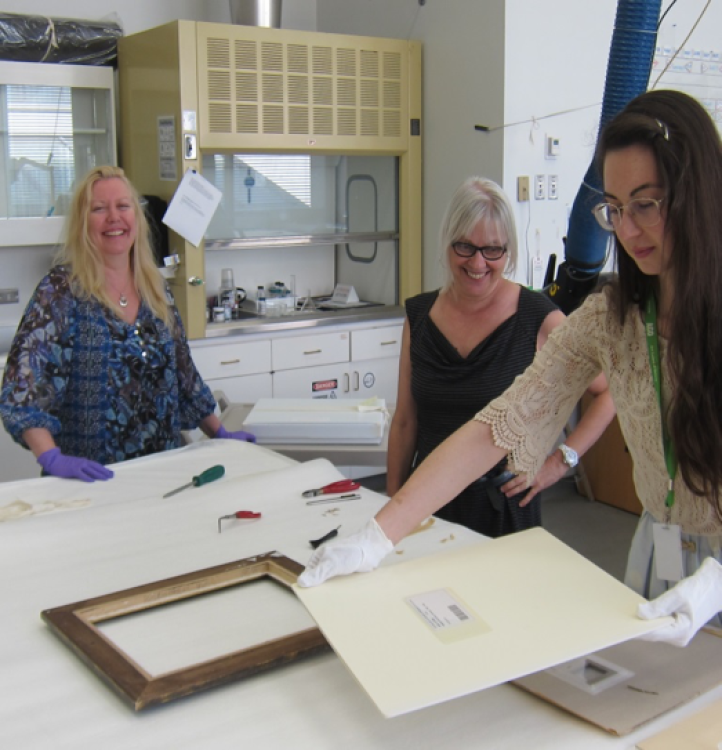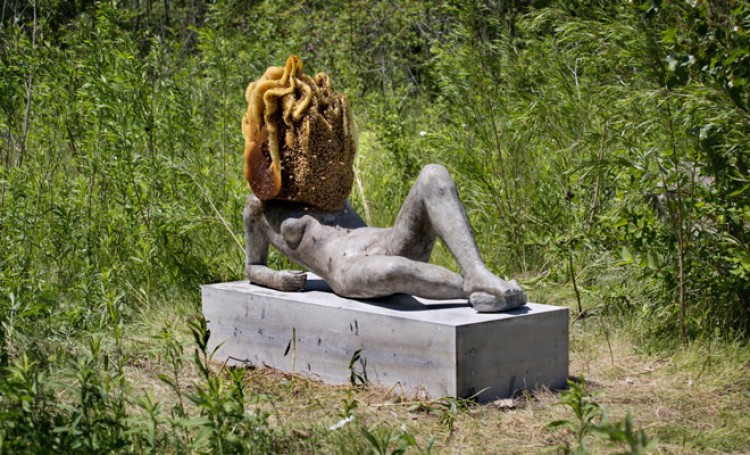Conservation Notes: The Mystery of the Molenaer

In celebration of the 100th anniversary of the Art Gallery of Ontario’s first exhibition, happening on June 5, 2013, the Conservation Department is highlighting a painting that was a part of that exhibition, entitled Landscape with Figures.
This painting was originally in the collection of the Boulton family, builders and first owners of The Grange. While we don’t know for sure whether it belonged to Sarah Anne or to Harriet Boulton, we do know that William and Harriet took an extended trip to Europe from 1856 to 1957. We also know that Landscape with Figures was not included in the 1852 bazaar for the liquidation of debt due on St. George the Martyr Church, which included many paintings from the Boultons, so they may not have owned the painting at that date. This may mean that it was more likely acquired by Harriet, rather than Sarah Anne. We can't be sure when the painting arrived at The Grange, but we do know that Harriet’s father was consul general to the Netherlands, and it's possible Harriet brought it with her from her childhood home in Boston.
From Molendi to Molenaer
In the summer of 2009, AGO conservation intern Emily Min made an amazing discovery. While cleaning a painting, a work at first attributed to unknown artist named “F. Molendi,” she discovered a gem amongst the soil, dust and debris. Surface cleaning revealed the signature, an obscured "K. Molenaer." Compared with other examples of this Dutch artist’s signature, we could see it was a match.
Klaes Molenaer (c. 1630-1676) was a moderately successful landscape painter from Haarlem, an active cultural centre and the most lucrative location for artists to work in the Netherlands during the 17th century. Painters who would have counted among Molenaer’s contemporaries included Frans Hals, Salomon van Ruysdael and Jan Steen. A work by Molenaer augments an already strong collection of 17th-century Netherlandish work — from what was to become known as the Dutch Golden Age — at the AGO, and we are fortunate to have found another example from this period.

Treatment details
A partial conservation treatment reveals the appearance of the artwork before treatment and at various points during treatment. On the left, a preliminary, new varnish layer has re-saturated the appearance of the paint layers, but we have not yet done the inpainting (retouching) and final varnishing. We've surface-cleaned the centre area and removed the old varnish layer towards the left and only partially towards the right. The right side still has the old varnish and surface soiling in place. Surface cleaning and removal of a discoloured varnish layer will brighten the overall painting and return it to a truer representation of the artist’s original intent. The signature in the bottom right corner — very dark and obscured by a discoloured varnish — only became evident through close scrutiny and chance positioning of a bright light.
Paint-sample analysis by the Canadian Conservation Institute identified the nature of the unusual dark spots visible throughout the sky. Originally we thought that a resin may be migrating from the wood support through the paint layers to the surface of the artwork. CCI was able to establish, however, that the disfiguring spots were more likely caused by a drying oil migrating from the paint layers or older coating below the uppermost paint layers.

Conservation treatment on Landscape with Figures will eventually be completed but for now the painting is an informative illustration of the various stages of a painting conservation treatment stopped mid-way. Surface cleaning and varnish removal will continue in the right side of the painting and we will re-join the top and bottom panels. This will be followed by the application of an isolating, preliminary varnish layer before we do precise retouching with modern paints to disguise the dark spots and better visually reintegrate them with the surrounding original paint layers. Only then will we apply a final overall varnish layer.
We know that the painting has been restored at some point in the past, because sample analysis also revealed the presence of pigments that would not have been available during the artist’s lifetime. These pigments, Prussian blue (available starting in 1704) and cobalt blue (available 1803-04) appear to have been used to cover the disfiguring brown spots. We found the later pigments on top of a varnish layer, with original paint below.
Though we were able to identify the artist behind the work, the mystery remains as to how this painting came to Canada. Still, Harriet would have known that she owned a Molenaer, and now that the grit and grime from years of gas lighting and coal fires has been removed, so do we.
Compiled by Stephanie Gibson, Sherry Phillips, Jenny Rieger, Maria Sulliva
Signature Partner of the AGO’s Conservation Program
Signature Partner of the AGO’s Conservation Program





